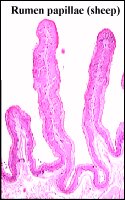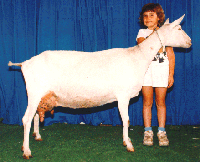VIVO Pathophysiology
Nutrient Absorption and Utilization in Ruminants
Volatile fatty acids (VFA) are produced in large amounts through ruminal fermentation and are of paramount importance in that they provide greater than 70% of the ruminant's energy supply. Virtually all of the acetic, proprionic and butyric acids formed in the rumen are absorbed across the ruminal epithelium, from which they are carried by ruminal veins to the portal vein and hence through the liver. Continuous removal of VFA from the rumen is important not only for distribution, but to prevent excessive and damaging drops in pH of rumen fluid.
 The rumen is lined with stratified squamous epithelium similar to skin, which is generally not noted for efficient absorption. Nonetheless, this squamous epithelium has a structure which functions similarly to the columnar epithelium in the small gut and performs efficient absorption of VFA, as well as lactic acid, electrolytes and water. Recall also, that the epithelial surface is expanded greatly by formation of well-vascularized papillae.
The rumen is lined with stratified squamous epithelium similar to skin, which is generally not noted for efficient absorption. Nonetheless, this squamous epithelium has a structure which functions similarly to the columnar epithelium in the small gut and performs efficient absorption of VFA, as well as lactic acid, electrolytes and water. Recall also, that the epithelial surface is expanded greatly by formation of well-vascularized papillae.
It is of considerable practical importance that the size and length of ruminal papillae respond to concentrations of VFA in the rumen. Animals that have been on a high plane of nutrition, with abundant VFA production, have long, luxuriant papillae well suited to promote absorption. In contrast, animals which have been under nutritional deprivation have small, blunted papillae, and require time on a high quality diet to allow for development of their papillae and absorptive capacity.
All the VFA appear to be absorbed by the same mechanism, which is diffusion through the epithelium, down a concentration gradient. As they pass through the epithelium, the different VFA undergo different degrees of metabolism. Acetate and proprionate pass through the epithelium largely unchanged, but almost all of the butyric acid is metabolized in the epithelium to beta-hydroxybutyric acid, a type of ketone body.
The three major VFA absorbed from the rumen have somewhat distinctive metabolic fates:
- Acetic acid is utilized minimally in the liver, and is oxidized throughout most of the body to generate ATP. Another important use of acetate is as the major source of acetyl CoA for synthesis of lipids.
- Proprionic acid is almost completely removed from portal blood by the liver. Within the liver, proprionate serves as a major substrate for gluconeogenesis, which is absolutely critical to the ruminant because almost no glucose reaches the small intestine for absorption.
- Butyric acid, most of which comes out of the rumen as the ketone beta-hydroxybutyric acid, is oxidized in many tissues for energy production.
 Let's put some of the academic information presented here into perspective. The little goat pictured here weighed about 200 lb when this picture was taken and produced 1570 kg of milk in a 305 day lactation. Her milk was roughly 4% lactose, 3.5% protein and 3.6% fat. This means that, for the sole task of producing milk, this goat has to synthesize about 250 grams of lactose and 180 grams of protein and 185 grams of fat every day.
Let's put some of the academic information presented here into perspective. The little goat pictured here weighed about 200 lb when this picture was taken and produced 1570 kg of milk in a 305 day lactation. Her milk was roughly 4% lactose, 3.5% protein and 3.6% fat. This means that, for the sole task of producing milk, this goat has to synthesize about 250 grams of lactose and 180 grams of protein and 185 grams of fat every day.
Essentially all the glucose in that lactose was synthesized in the liver and most of that synthesis was from proprionic acid generated by fermentation. Likewise, much of the fat as synthesized from ruminal acetate. When you consider that synthesis of lactose and milk fat are only two of many, many processes that are supported by volatile fatty acids, the process of fermentation in herbivores gains new meaning.
Send comments to Richard.Bowen@colostate.edu

